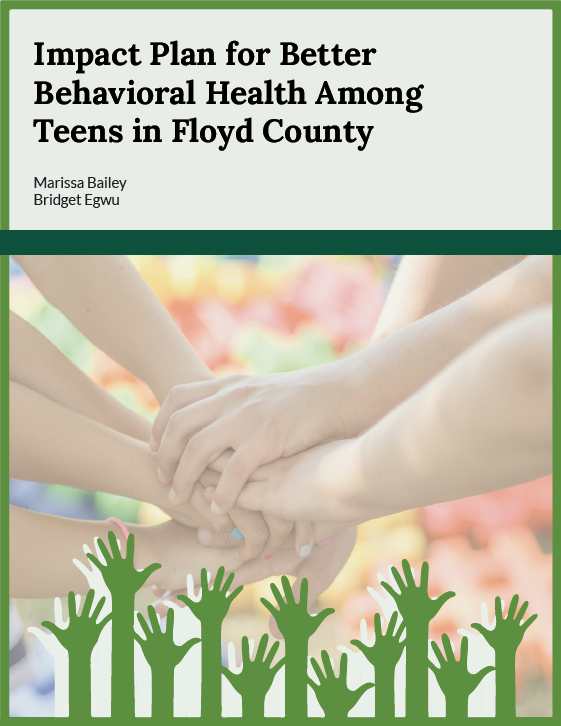Impact Plan for Better Behavioral Health Among Teens in Floyd County
An impact plan report on reducing substance abuse and suicide ideation in Floyd County Teens.
Objective
I wrote this impact plan report as a final deliverable for an internship that was part of a grant program I participated in. The grant supported students who participated in a year-long study program to improve behavioral health outcomes in rural or underserved communities. The overall project was a team assignment that I worked on with a partner, but this report was one of my deliverables, so I am the sole creator of it. This report details the impact plan we created, how we implemented our plan, what impact it had on the community we worked with, and how we could utilize or build on this strategy in the future.
Tasks
• Identify an opportunity for improving behavioral health in a rural or underserved community
• Conduct research into the topic and discover an opportunity for interdisciplinary collaboration
• Create an initiative or intervention that can be implemented during the timeframe of the internship
• Write an impact plan for the initiative, including a list of goals that are specific, measurable, achievable, relevant, and time-bound
• Obtain input from diverse stakeholders in the community
• Implement the plan and achieve a measurable impact in the community
• Consider ways the initiative or intervention can be continued after the internship
• Write a present a report detailing the research, plan, goals, outcomes, and effects of the initiative
Process
The goal of this project was to promote better behavioral health in rural or underserved communities through community engagement. In order to find out more about the specific issues that affect rural and underserved communities, my partner and I conducted research into the subject. During this same period, we also worked at an internship for Rome Floyd County Commission on Children and Youth in Floyd County as part of our grant requirements. Throughout the previous year, we had completed coursework in a variety of areas related to bettering behavioral health and community engagement. All of these experiences informed our plan.
While writing this report, I chose to combine IMRaD style with a traditional findings report style. Our assignment called for both a literature review and a methods section, so I decided that starting with the IMRaD style was the best option. As I worked through writing the report, I discovered that it had somewhat different components that fit better with a traditional findings report style. I decided to combine the two styles by including an executive summary and other traditional components of a findings report around the IMRaD sections I’d already written.
Design
When creating the layout and design of this report, I chose to use the same colors that we used for our Teen Resource Guide. I also attempted to vary the composition of the pages enough that it maintained visual interest and improved readability, but not so much that it lost its sense of consistency. I included stock images where appropriate to add visual appeal. This report was also intended to accompany a presentation, so visual appeal was an important element in the design.
Takeaways
I had many takeaways from this project as a whole and from this report, including the importance of a research-informed approach, interdisciplinary collaboration, diverse stakeholder input, and understanding audience needs. Without the collaboration between us, our instructors, our program coordinator, our internship supervisor, and the stakeholders we reached out to, we would not have been able to create a guide that met the needs of our audience. We also wouldn’t have been able to achieve the same goals and outcomes we achieved with this project. Above all else, this project taught me to value working as part of a collaborative interdisciplinary team.
